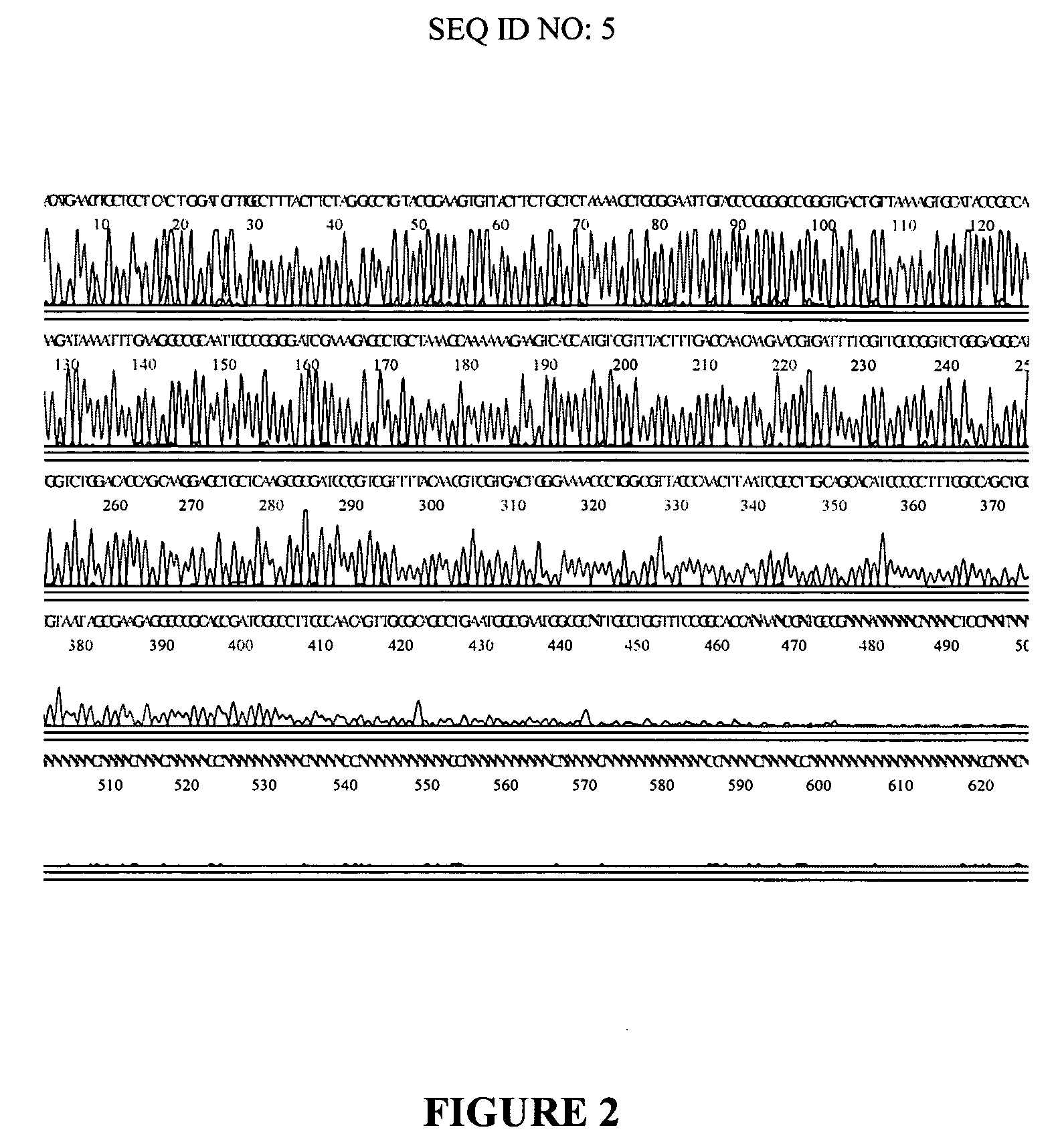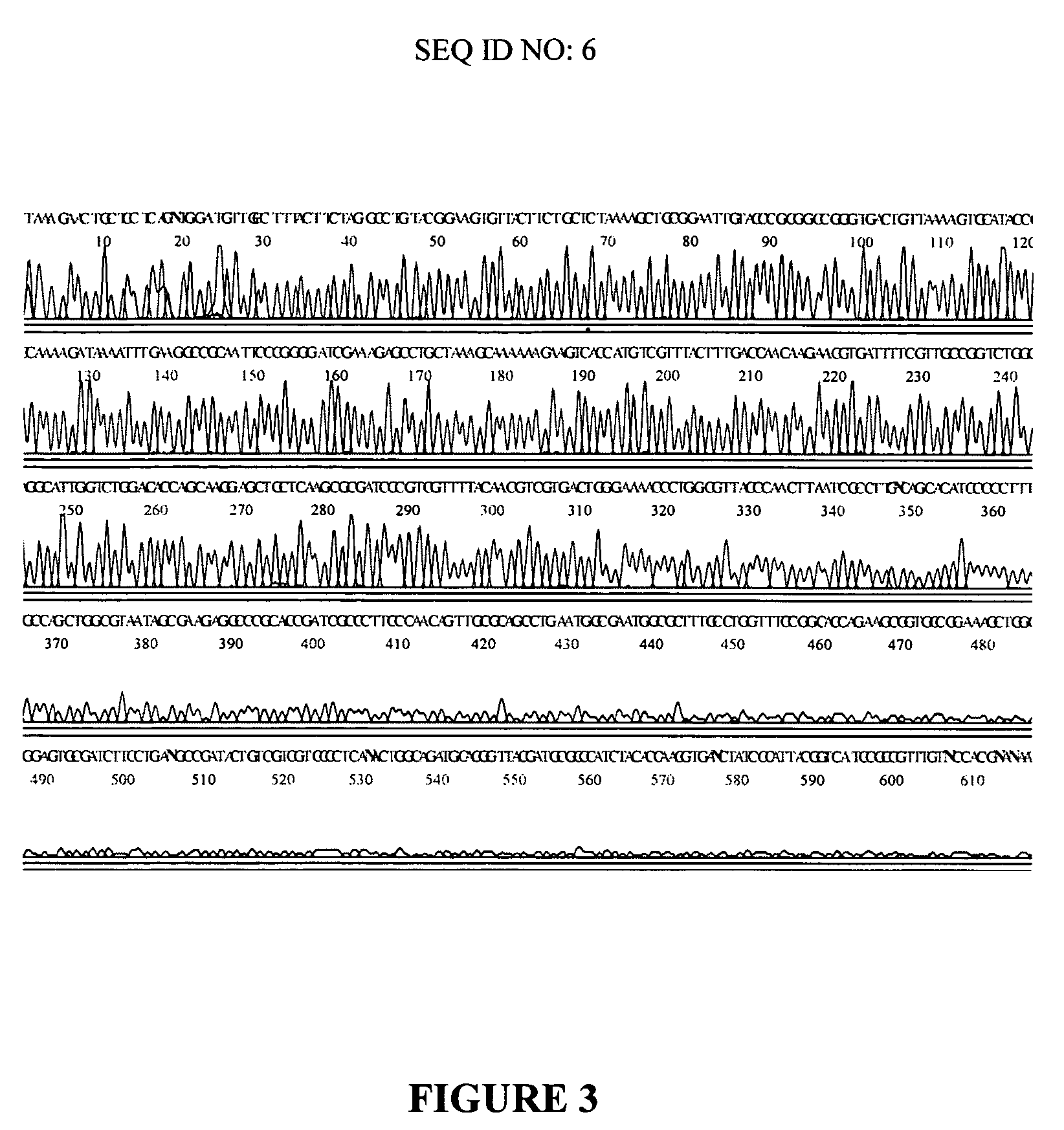Multiply-primed amplification of nucleic acid sequences
a nucleic acid sequence and primer technology, applied in the field of multi-primed amplification of nucleic acid sequences, can solve the problems of inability to achieve the effect of preventing certain electrophoresis artifacts and stronger base pairs
- Summary
- Abstract
- Description
- Claims
- Application Information
AI Technical Summary
Benefits of technology
Problems solved by technology
Method used
Image
Examples
example 1
Sequencing Template DNA Made by Standard or Modified Multiply-Primed Amplification
a) Standard Multiply-Primed Amplification (MPA)
[0073] Amplification was carried out starting with 2 ng of double-stranded plasmid DNA (for example pNASS β DNA from Clonetech; Genbank XXU02433) in a 20 μl reaction volume containing 50 mM Tris-HCl, pH 8.25, 10 mM MgCl2., 0.01% Tween-20, 75 mM KCl, 0.2 mM dATP, 0.2 mM dTTP, 0.2 mM dCTP and 0.2 mM dGTP, 100 pmoles (200 ng) of random hexamer and 100 ng φ 29 DNA polymerase. The reaction mixture was incubated at 30° C. for 16 hours to allow amplification of the DNA, and then incubated at 65° C. for 10 minutes to inactivate the polymerase. Typical yield is 2-4 μg of DNA product as measured by fluorescence assay using Picogreen dye (Molecular Probes).
b) Modified Multiply-Primed Amplification (mMPA)
[0074] The above standard amplification reaction was modified by omitting 0.2 mM dGTP and substituting 0.4 mM dITP alone or a mixture of 0.8 mM dITP and 0.05 m...
example 2
The Melting Temperature (Tm) of DNA Amplified by Standard or Modified Multiply-Primed Amplification
[0078] DNA (plasmid pNASSβ) was amplified by Multiply-Primed Amplification with 0.2 mM dGTP (Standard) or 0.4 mM dITP or a mixture of 0.8 mM dITP and 0.05 mM dGTP as described in detail in Example 1. 20 reaction mixtures of 20 μl each were incubated at 30° C. for 16 hours, and then incubated at 65° C. for 10 minutes.
[0079] Each batch of 20 reactions was pooled together, precipitated by ethanol and resuspended in 400 μl of 1×SSC buffer (150 mM NaCl, 15 mM Na3 Citrate). The OD at 260 nm was adjusted to be in the range of 0.2 to 0.5 using 1×SSC buffer in order to perform Tm measurements. The OD at 260 nm was measured as temperature changed from 30° C. to 98° C. using a Lambda 25 UVN is Spectrophotometer (Perkin Elmer Inc.). The Tm of the DNA was determined as the peak in the first derivative of the OD260 vs temperature curve which is also approximately the temperature at which 50% of t...
example 3
Reaction Products of Modified Multiply-Primed Amplification (mMPA) can be Cycle Sequenced at Lower Temperatures than Products of Standard Multiply-Primed Amplification (MPA).
[0080] A randomly selected clone from a library of T. Volcanium DNA in pUC 18 was amplified by Standard (dGTP) Multiply-Primed Amplification or modified (a mixure of dITP and dGTP) Multiply-Primed Amplification as described in detail in Example 1. Then sequencing reactions were carried out using 5 pmoles of −40 Universal M13 primer and 8 μl of DYEnamic ET terminator premix and 5 μl of the amplified DNA. Reactions were cycled at normal temperatures (30 times at 95° C., 20 seconds, 50° C., 30 seconds and 60° C., 60 seconds) or at low temperatures (30 times at 82° C., 20 seconds, 40° C., 30 seconds and 50° C., 60 seconds). Samples were precipitated by ethanol, dissolved in 20 μl of 95% formamide and run on a MegaBACE 1000 capillary sequencing instrument (Amersham Biosciences). The electropherogram obtained with t...
PUM
| Property | Measurement | Unit |
|---|---|---|
| Tm | aaaaa | aaaaa |
| Tm | aaaaa | aaaaa |
| Tm | aaaaa | aaaaa |
Abstract
Description
Claims
Application Information
 Login to View More
Login to View More - R&D
- Intellectual Property
- Life Sciences
- Materials
- Tech Scout
- Unparalleled Data Quality
- Higher Quality Content
- 60% Fewer Hallucinations
Browse by: Latest US Patents, China's latest patents, Technical Efficacy Thesaurus, Application Domain, Technology Topic, Popular Technical Reports.
© 2025 PatSnap. All rights reserved.Legal|Privacy policy|Modern Slavery Act Transparency Statement|Sitemap|About US| Contact US: help@patsnap.com



